Understanding how substance use affects brain chemistry
Decoding the Neurochemical Impact of Substance Use
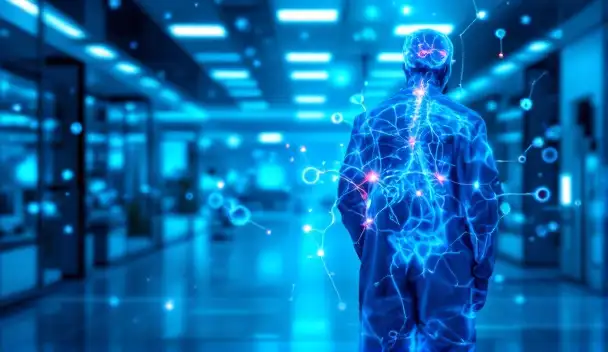
Introduction to Brain Chemistry and Substance Use
The human brain, a marvel of biological complexity, governs everything from basic bodily functions to complex behaviors. At its core are neurons that communicate through intricate chemical signals known as neurotransmitters. When substances such as drugs enter this delicate system, they can hijack neural pathways, leading to profound neurochemical and structural changes. This article explores the mechanisms by which substance use influences brain chemistry and the implications for addiction and health.
The Brain's Foundation: Neurons and Neurotransmitters
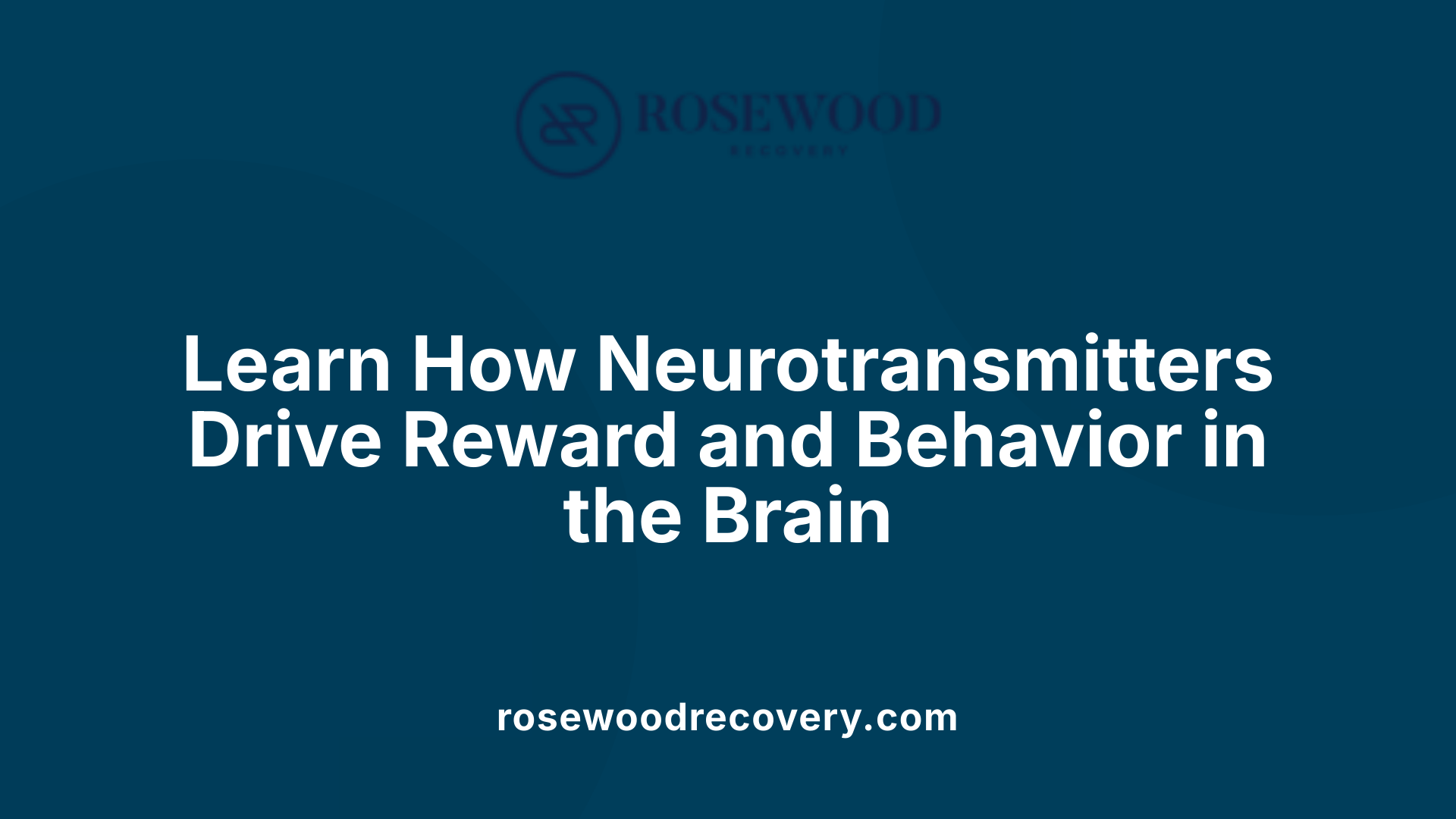
How does substance use impact brain chemistry and neurobiology?
Substance use profoundly affects the brain's chemistry and neurobiology by disrupting the normal functioning of neurotransmitter systems. Central to this disruption is the dopamine system, particularly in the reward pathways such as the nucleus accumbens. When a person uses addictive substances like opioids, cocaine, or nicotine, these drugs trigger an outsized surge of dopamine—up to ten times more than natural rewards like food or social interaction.
This excessive release of dopamine reinforces drug-taking behavior by creating intense feelings of pleasure or euphoria. Over time, the brain adapts to these changes by reducing the number of dopamine receptors and increasing the transporters that remove dopamine from synapses. These neuroadaptations diminish the brain's response to natural rewards and lead to tolerance, requiring higher or more frequent drug use to achieve the same effect.
Chronic substance use also causes lasting structural and functional changes across key brain areas involved in reward, emotion, and decision-making. The basal ganglia, particularly the nucleus accumbens and dorsal striatum, are heavily affected, leading to strengthened neural pathways that favor drug-seeking behaviors. The extended amygdala plays a role in stress and negative emotions, becoming hyperactive during withdrawal, which intensifies craving and distress.
The prefrontal cortex, responsible for decision-making and impulse control, undergoes impairments that contribute to compulsive drug use. These alterations disrupt executive functions, making it harder for individuals to resist urges or weigh long-term consequences. The combined effect of these neurobiological changes manifests as a cycle of binge/intoxication, withdrawal/negative states, and preoccupation/anticipation, perpetuating addiction.
In addition to altering neurotransmitter activity, substances can cause structural brain changes, neuroinflammation, and genetic modifications. These effects may persist long after stopping drug use, making recovery challenging. Furthermore, substance-induced neurochemical imbalances can lead to cognitive impairments in memory, learning, attention, and judgment, often contributing to behavioral and emotional problems.
In summary, drugs hijack the brain's natural reward and emotional circuits, causing widespread neurobiological alterations that sustain addiction and hinder recovery processes. These modifications are stage-specific but can be partially reversible with appropriate treatment and sustained abstinence.
Drug Actions: Modulating Neural Communication
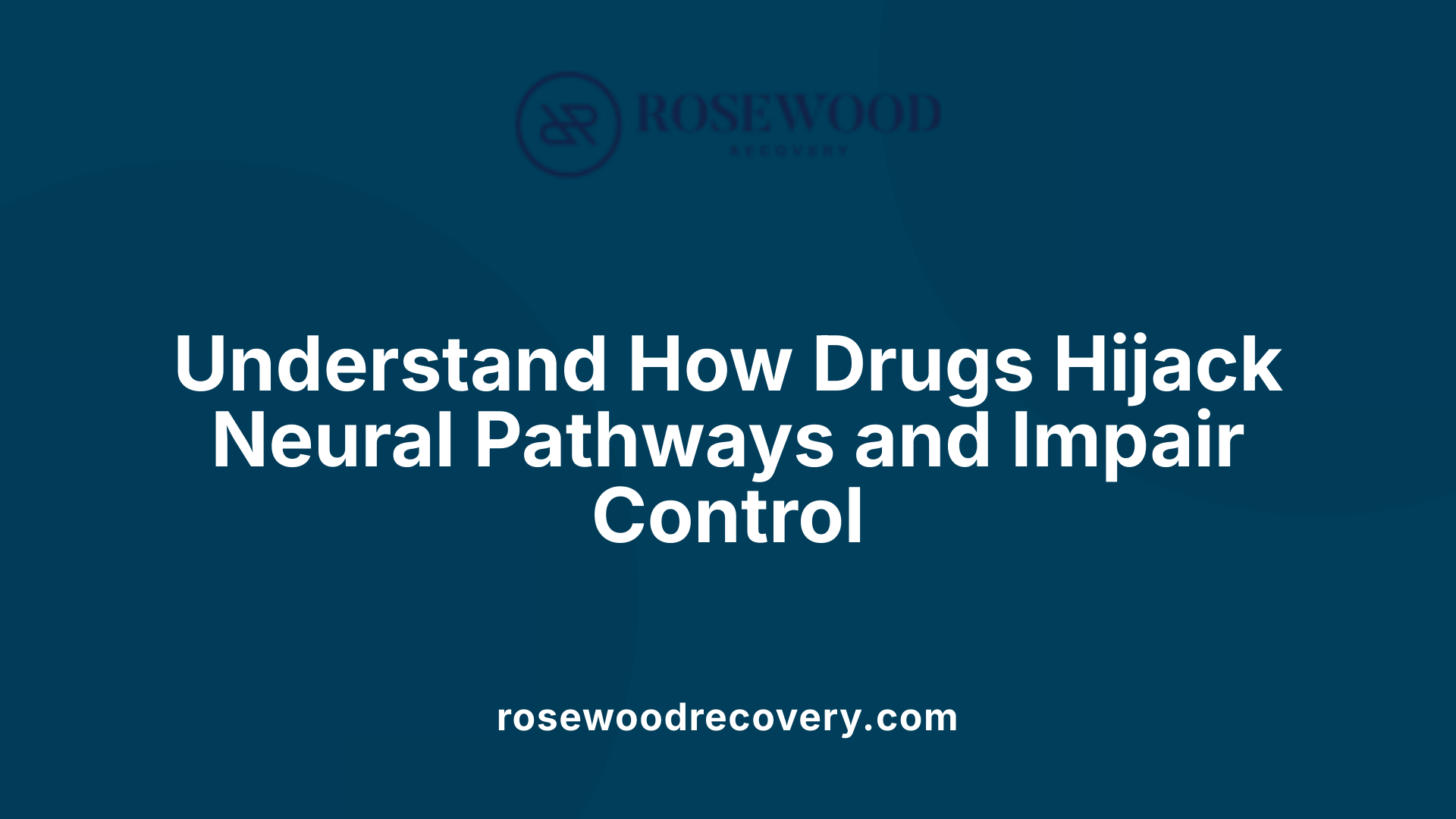
How do drugs affect neural communication and the brain regions involved in reward and impulse control?
Drugs impact the brain’s communication system primarily by changing how neurons release neurotransmitters, how they respond to these chemicals through receptors, and how connections between neurons adapt over time. Most addictive substances target the mesolimbic dopamine pathway, a central circuit involved in pleasure and reward.
When drugs like cocaine, opioids, or nicotine are introduced, they trigger large surges of dopamine in the nucleus accumbens, a key structure within the reward system. These surges are much greater than those produced by natural rewards such as food or social interactions, creating intense feelings of euphoria. This activation reinforces drug use by strengthening the neural pathways associated with pleasure.
Chronic exposure to drugs causes the brain to undergo neuroadaptive changes, which include reductions in dopamine receptor numbers and increased dopamine transporter activity. These changes make the brain less responsive to natural rewards, leading to diminished pleasure from everyday activities—a phenomenon called anhedonia.
At the same time, the usual balance of activity between brain regions involved in decision-making and impulse control becomes disrupted. The prefrontal cortex, responsible for judgment and self-control, shows decreased functional capacity, which impairs a person’s ability to resist cravings and make rational choices about drug use.
Furthermore, regions like the extended amygdala, which deal with stress and negative emotional states, become hyperactive during withdrawal, intensifying cravings and emotional distress. The dorsal striatum, involved in habit formation, becomes more engaged in habitual drug seeking.
These neuroplastic changes involve molecular pathways such as mTOR signaling, which influences synaptic remodeling and strengthens associations with drug-related cues. As a result, behaviors shift from voluntary to compulsive, driven more by habit and craving than by rational decision.
Over time, these alterations in brain circuitry diminish the individual’s ability to experience pleasure from natural sources, increase tolerance requiring higher drug doses to achieve the same high, and contribute to the cycle of addiction. Notably, these changes can persist long after stopping drug use, creating a lasting vulnerability and making recovery challenging.
In summary, drugs hijack the brain’s natural reward and stress systems, leading to profound neurochemical and structural modifications. These changes disrupt normal motivation, impulse control, and emotional regulation, laying the foundation for addictive behaviors.
| Brain Region | Role in Reward & Control | Effect of Drugs | Resulting Behavior |
|---|---|---|---|
| Nucleus Accumbens | Pleasure processing | Dopamine surge | Euphoria, reinforcement |
| Prefrontal Cortex | Decision-making, impulse control | Reduced activity, altered synapses | Impaired judgment, cravings |
| Extended Amygdala | Stress, emotional regulation | Hyperactivation during withdrawal | Anxiety, negative emotional states |
| Dorsal Striatum | Habit formation | Increased activity in habitual seeking | Compulsive drug pursuit |
These neuroanatomical changes underscore how drugs rewire brain circuits, fostering addiction by over-activating reward pathways and impairing the circuits that inhibit compulsive behaviors.
Understanding the Biological Mechanisms of Addiction
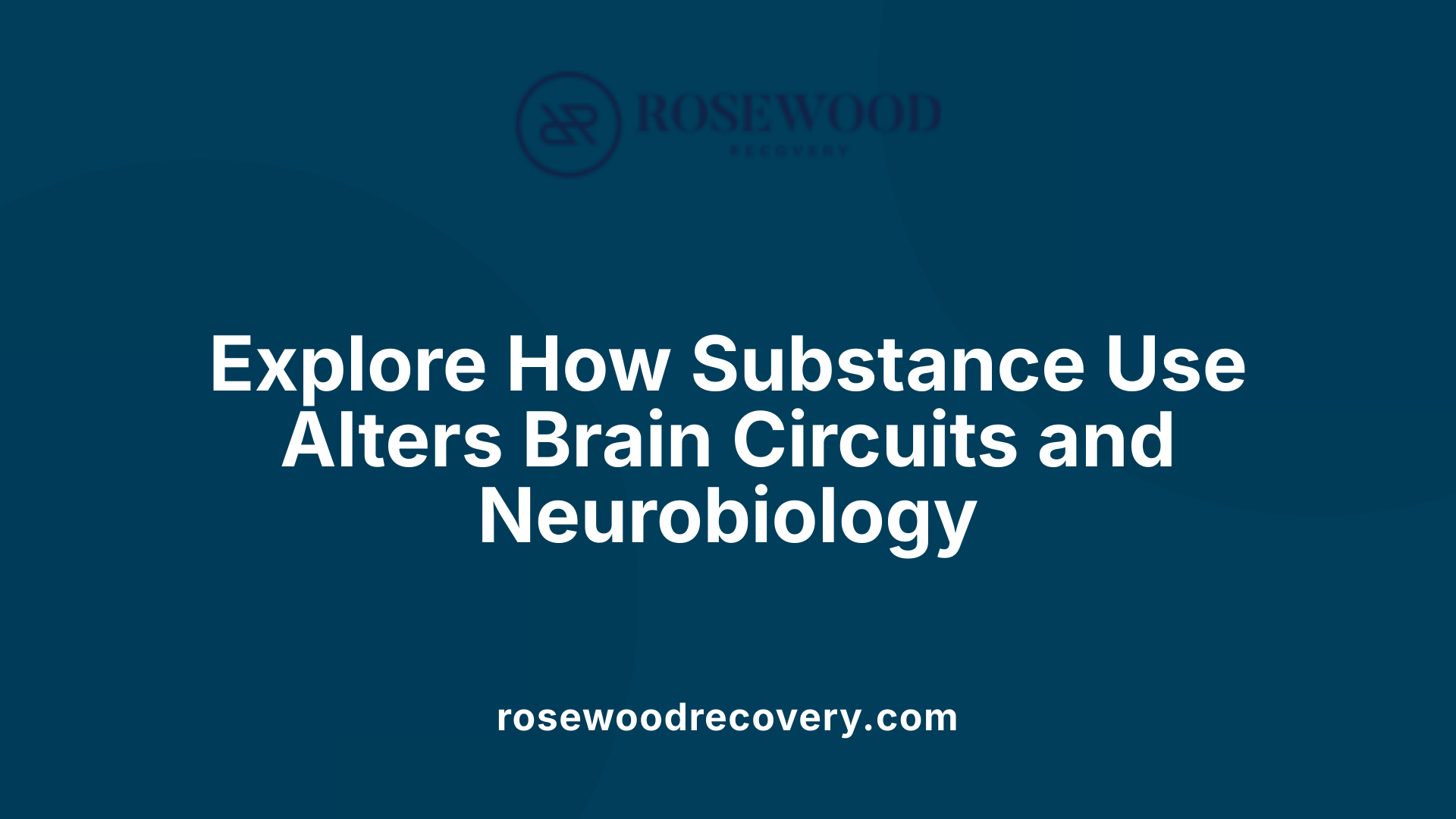
What are the biological mechanisms of addiction and how do substances alter brain circuits over time?
Addiction is fundamentally a brain disease characterized by profound neuroadaptations within key neural circuits responsible for reward, motivation, and self-control. The central system involved is the mesocorticolimbic dopamine pathway, which includes regions such as the nucleus accumbens, dorsal striatum, and the prefrontal cortex.
During initial substance use, addictive drugs like opioids, cocaine, or nicotine cause an outsized surge of dopamine in the reward pathway—up to ten times higher than natural rewards such as food or social interactions. This intense activation produces feelings of euphoria and reinforces drug-taking behavior.
Repeated drug exposure leads to significant neuroplastic changes. Synaptic strengthening—also called potentiation—occurs especially in the nucleus accumbens, making drug cues more salient and cravings more intense. At the same time, the brain reduces the number of dopamine D2 receptors and increases dopamine transporters, which lowers sensitivity to natural rewards and contributes to feelings of anhedonia, a loss of pleasure from normally enjoyable activities.
Beyond neurotransmitter changes, structural alterations also manifest. These include decreased gray matter volume in the prefrontal cortex, impairing judgment and impulse control, and enhanced connectivity within habit-forming circuits like the dorsal striatum. Such neuroadaptations make drug use more habitual and less susceptible to rational decision-making.
The extended amygdala, a region involved in stress and negative emotions, becomes increasingly active during withdrawal, releasing stress-related neuropeptides such as corticotropin-releasing factor (CRF). This shift contributes to the negative emotional states—such as anxiety and dysphoria—that often drive ongoing drug use.
Epigenetic mechanisms, including DNA methylation and histone modifications, also play roles by altering gene expression in addiction-related regions, cementing these neuroplastic changes.
Over time, these neurobiological changes induce a cycle of addiction, with phases of binge/intoxication, withdrawal/negative affect, and preoccupation/anticipation. During the third phase, impaired prefrontal cortex activity hampers decision-making and impulse control, leading to compulsive drug-seeking despite adverse consequences.
Genetic and environmental factors modulate these neuroadaptations, influencing individual vulnerability to addiction. For example, early drug use or mental health conditions can accelerate or deepen these changes.
Understanding this complex neurobiology helps inform treatment strategies, which aim to reverse or compensate for these maladaptive circuit alterations. Approaches include medications that restore dopamine balance, behavioral therapies that modify neural pathways, and emerging interventions targeting specific neurochemical and structural aspects of addiction.
The long-lasting nature of these neurocircuitry alterations means that even after abstinence, craving and relapse risk persists. However, neuroplasticity also provides hope—continual brain adaptation can gradually restore normal functioning, reducing dependence and improving quality of life.
Brain circuits involved in addiction progression
| Brain Region | Function | Role in Addiction | Structural Changes | Neurochemical Effects |
|---|---|---|---|---|
| Nucleus Accumbens | Reward processing | Reinforces drug seeking | Increased connectivity with prefrontal cortex | Surges of dopamine and opioids enhance pleasure |
| Dorsal Striatum | Habit formation | Strengthens habitual drug-seeking | Increased synaptic strength driving compulsive behaviors | Dopamine modulates habit circuits |
| Prefrontal Cortex | Decision-making, impulse control | Impaired judgment, increased cravings | Reduced gray matter volume, decreased activity | Decreased control over drug seeking |
| Extended Amygdala | Stress, negative emotions | Activation during withdrawal, triggers negative affect | Increased activity during dependence | Stress-related neuropeptides like CRF release |
This table summarizes how specific brain regions are affected during different stages of addiction, highlighting their roles in reinforcing the cycle of drug use and relapse.
Understanding these interconnected circuits, neurochemical changes, and structural alterations provides insight into how addiction hijacks the brain's natural reward and stress systems. It also points to potential targets for novel treatments, aiming to modify or reverse maladaptive neuroadaptations, ultimately helping individuals recover from addiction.
Neurological and Physiological Consequences of Substance Use
What are the neurological and physiological impacts of various substances on brain health?
Substance use can significantly alter brain function and structure, leading to both neurological and physiological consequences. These impacts primarily stem from how drugs interfere with neurotransmitter systems, disrupting the brain’s natural signaling pathways that regulate mood, perception, and behavior.
Many addictive substances, including opioids, cocaine, nicotine, and cannabis, mimic or block the activity of natural neurotransmitters such as dopamine, serotonin, GABA, and endorphins. This mimicry results in abnormal activation of neurons, producing intense euphoria and reinforcing drug-taking behavior. Over time, repeated drug exposure induces structural changes in critical brain regions like the prefrontal cortex (responsible for decision-making and impulse control), basal ganglia (which processes reward and habit formation), and limbic system (governing emotions and memory).
Chronic use of these substances can lead to neurotoxicity, with evidence showing deterioration of white matter and reductions in overall brain volume. Such changes are associated with cognitive deficits, including impaired memory, diminished executive functioning, poorer decision-making, and trouble controlling impulses. Additionally, dysregulation of the brain’s reward circuitry diminishes sensitivity to natural rewards like food, social interactions, and other pleasurable activities, fostering dependence and addiction.
Beyond neurochemical alterations, substances such as alcohol and inhalants pose additional health risks. They can cause neurovascular damage, increasing the risk of strokes—both ischemic and hemorrhagic—by promoting vasoconstriction, hypertension, and damaging blood vessels within the brain.
The impact of drugs extends to the nervous system broadly, impacting neuromuscular function and leading to neurological disorders. For instance, substances like cocaine and amphetamines can induce movement disorders, tremors, or muscle spasms during intoxication or withdrawal phases. Furthermore, prolonged exposure might cause things like neuropathies, myopathy, or developmental delays in brain wiring.
From a physiological perspective, substance abuse increases the risk of traumatic brain injury (TBI) due to risky behaviors driven by impaired judgment and disinhibition. Moreover, certain drugs exacerbate cerebrovascular issues, contributing to strokes or vascular damage that precipitate irreversible brain injury.
In terms of muscle and nerve health, substances like alcohol, heroin, and inhalants are linked to neuropathies, muscle weakness, and disorders such as Guillain-Barré syndrome. During intoxication or withdrawal, movement disorders including tremors and involuntary movements may occur.
Effective treatment of these neurological and physiological impacts involves detoxification, medical management, and rehabilitation strategies aimed at restoring brain function and preventing further damage. Some effects can resolve if drug use ceases, but long-lasting changes challenge recovery and may trigger persistent cravings.
In summary, drug-induced alterations in brain chemistry, structure, and vascular integrity underscore the profound neurophysiological effects of substance use. The neurotoxicity and nervous system impacts highlight the importance of understanding these consequences for better prevention, diagnosis, and treatment of substance use disorders.
Long-term Brain Changes Due to Substance Use
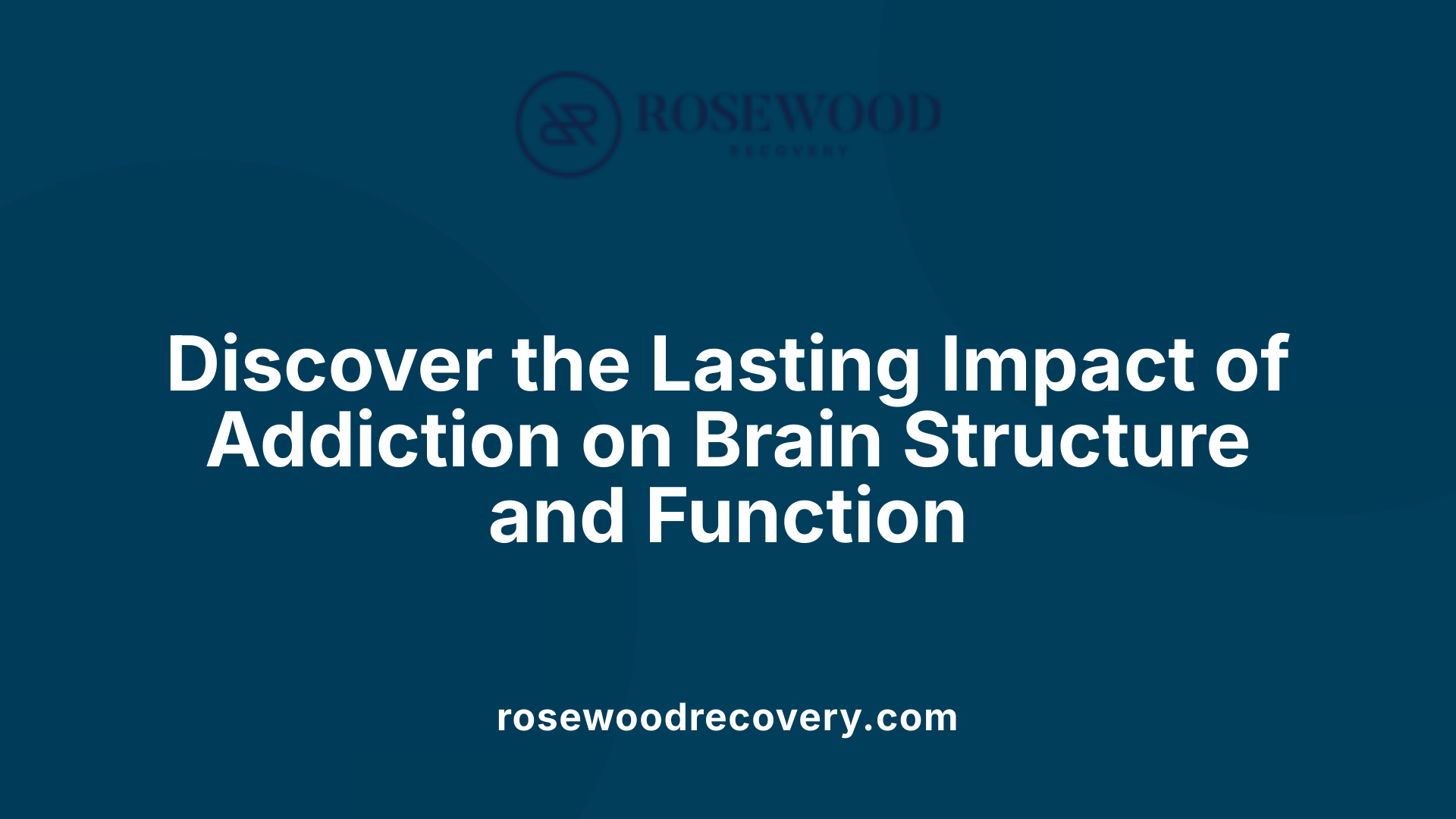
What are the long-term effects of substance use on brain structure and function?
Chronic substance use leads to profound and lasting alterations in the brain's architecture and operational capacity. These changes primarily impact regions responsible for reward processing, decision-making, impulse control, and emotional regulation, such as the prefrontal cortex, basal ganglia, and extended amygdala.
One significant impact is the reduction in grey matter volume within these regions, which can diminish cognitive abilities including memory, attention, and executive functions. This reduction reflects the loss or atrophy of nerve cells and synapses due to neurotoxic effects of addictive substances.
Structural damage is also evident in the white matter tracts that facilitate communication between different brain areas. Disruption of these neural pathways impairs the efficiency of information transfer, resulting in slowed cognition and difficulty integrating emotional and logical responses.
Neurotransmitter systems are markedly affected; for example, prolonged drug use often results in decreased sensitivity of dopamine receptors and increased levels of dopamine transporters. These adaptations diminish the brain’s natural ability to generate pleasure from everyday activities, contributing to symptoms like anhedonia.
Brain imaging studies reveal that such neuroadaptations can persist for months or even years after stopping drug use, maintaining a state of vulnerability. This enduring neurobiological footprint underpins persistent cravings, susceptibility to relapse, and mental health issues like depression and anxiety.
In addition to cognitive and emotional deficits, long-term substance use can cause physical brain damage. This includes increased risk of stroke due to vascular damage, movement disorders such as tremors or involuntary movements, and neuromuscular problems like neuropathy or myopathy.
Structural and functional impairments also extend to the brain's capacity for learning and behavioral adaptation. The weakened prefrontal cortex's impaired judgment and impulse control foster compulsive drug-seeking behaviors that are difficult to break.
Overall, the neurobiological effects of substance addiction are extensive, involving structural destruction and functional impairments that persist long-term. These chronic changes underscore that addiction is a persistent brain disease requiring sustained intervention and support.
Implications for cognition and behavior
The long-lasting brain alterations caused by substance use significantly impair cognition, affecting processes like decision-making, problem-solving, and emotional regulation. Individuals may experience amplified impulsivity, poor judgment, and difficulty resisting cravings.
Behaviorally, these neurological deficits manifest as compulsive drug-seeking and difficulty sustaining abstinence. The impaired neural circuits hinder the ability to evaluate long-term consequences, reinforcing destructive habits.
Furthermore, the persistent damage to brain regions involved in emotion regulation can lead to mood disorders, such as depression and anxiety, which both contribute to ongoing substance use and complicate recovery.
Despite the severity of these long-term effects, the brain’s neuroplasticity offers hope. With continued abstinence, many of these neurobiological changes can reverse or lessen over time, facilitating gradual recovery of brain function.
| Brain Region | Long-term Impact of Substance Use | Behavioral and Cognitive Outcomes |
|---|---|---|
| Prefrontal Cortex | Reduced volume, impaired executive functions, poor judgment | Impulsivity, difficulty decision-making, increased relapse risk |
| Basal Ganglia | Altered structure affecting reward and habit formation | Habitual substance-seeking, diminished response to natural rewards |
| Extended Amygdala | Changes in stress and emotional regulation | Elevated stress, negative mood states, withdrawal symptoms |
| White Matter Tracts | Disrupted communication pathways | Slower processing, difficulty integrating emotions and cognition |
This table illustrates how different brain areas are affected in the long term, leading to complex cognitive and behavioral challenges that require comprehensive treatment approaches.
The Neurobiology of Addiction and Dependency
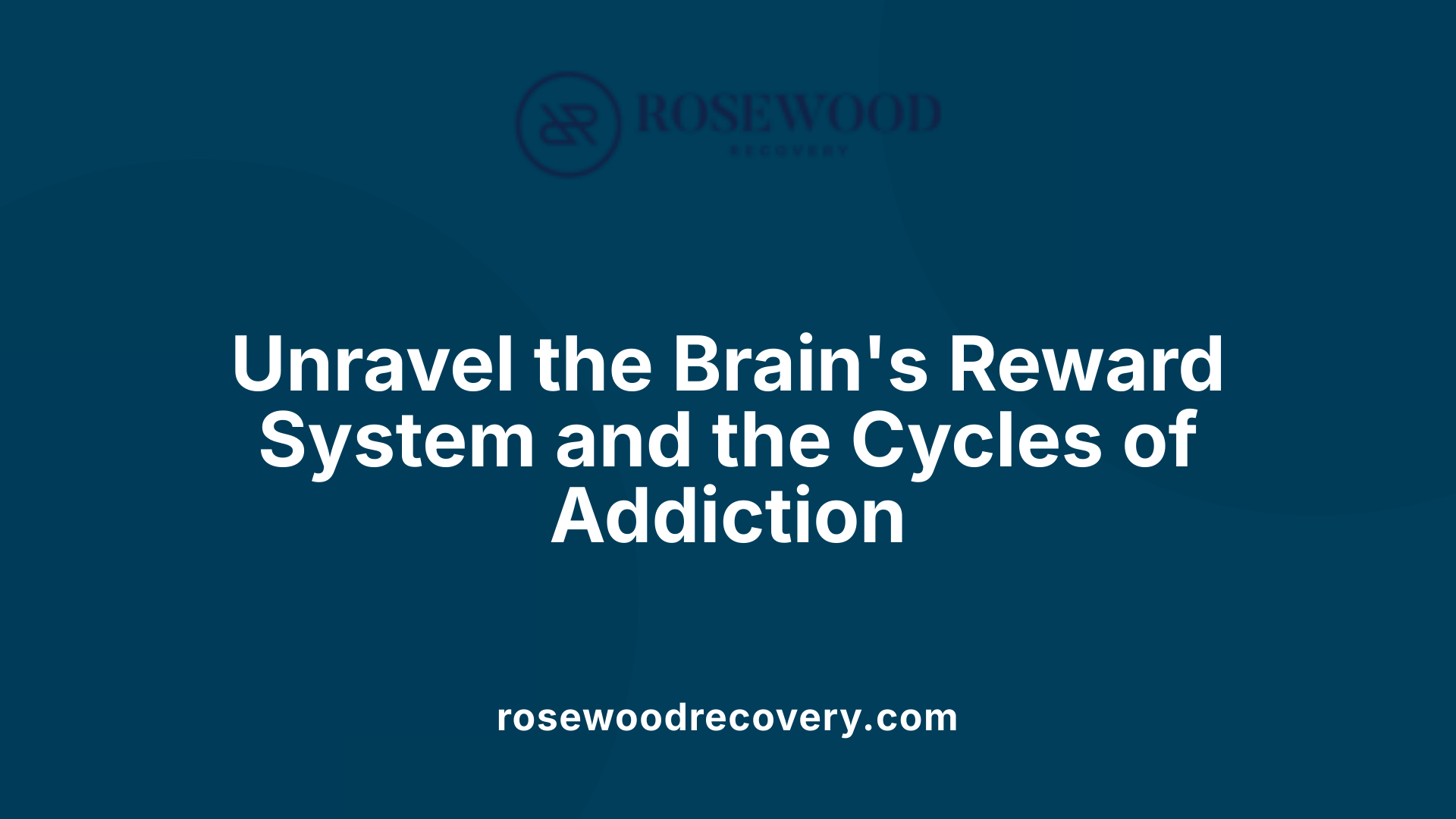
What is the neurobiological basis of addiction and dependency?
Addiction originates from complex changes within the brain's neural circuits responsible for reward, motivation, emotion, and decision-making. The core of these alterations involves the mesolimbic dopamine system, which includes key regions such as the ventral tegmental area (VTA) and the nucleus accumbens, often referred to as the brain's reward center.
During the initial stage of addiction, known as binge or intoxication, addictive substances like opioids, cocaine, and nicotine cause a rapid surge of dopamine and opioid peptides. These surges produce feelings of euphoria and reinforce drug-seeking behaviors by activating reward pathways strongly exaggerated compared to natural rewards like food or social interactions.
However, with repeated use, the brain adapts to these intense stimuli. It reduces the number and sensitivity of dopamine receptors, and increases the number of dopamine transporters, resulting in decreased responsiveness to both drugs and natural rewards. This process is called tolerance and often leads users to consume higher doses for the same effect.
Withdrawal symptoms emerge when drug levels decrease, activating stress systems such as corticotropin-releasing factor (CRF) and the extended amygdala. This activation contributes to negative emotional states like anxiety, irritability, and dysphoria, which drive individuals to use substances again to alleviate these feelings.
As addiction progresses, impairments in the prefrontal cortex—a brain area involved in decision-making, judgment, and impulse control—become prominent. Disruptions here diminish rational control over drug-seeking behaviors, making habits reflexive and compulsive.
Genetic predispositions and epigenetic modifications further influence vulnerability to addiction. Variations in genes affecting neurotransmitter systems such as dopamine, GABA, glutamate, and serotonin can increase susceptibility to substance use disorders. Early exposure to drugs and environmental factors can induce epigenetic changes—chemical modifications to DNA that do not alter genetic code but affect gene expression—thus impacting brain plasticity related to addiction.
Overall, addiction entails persistent neurobiological alterations that sustain compulsive drug use despite harmful consequences. Emerging treatments aim to target these neuroadaptations, potentially reversing or mitigating the brain changes to reduce cravings and prevent relapse.
Brain circuits involved in addiction stages
The addiction cycle comprises three main stages: binge/intoxication, withdrawal/negative affect, and preoccupation/anticipation.
| Stage | Brain Regions | Neurochemical Processes | Effects and Implications |
|---|---|---|---|
| Binge/Intoxication | Nucleus accumbens, dorsal striatum | Activation of dopamine and opioid systems | Produces euphoria and reinforces drug-taking, strengthening neural pathways |
| Withdrawal/Negative Affect | Extended amygdala, stress-related circuits | Activation of stress neurotransmitters like CRF | Leads to negative emotional states, driving compulsive use to avoid discomfort |
| Preoccupation/Anticipation | Prefrontal cortex | Impaired judgment and impulse control | Results in craving, risk of relapse, and habitual behaviors |
This cycle underscores the dynamic alterations across brain regions during addiction, illustrating how drug effects evolve from reward to craving and compulsive use.
Genetic and epigenetic influences
Individual vulnerability to addiction is significantly shaped by genetic factors. Variations in certain genes influence neurotransmitter functions, affecting how an individual experiences and responds to drugs.
Traits like impulsivity and existing mental health disorders also heighten risk. Notably, the brain continues to develop until about age 25, making early drug use especially hazardous.
Epigenetic modifications, such as DNA methylation or histone modifications, occur due to environmental exposures like stress or substance use. These changes alter gene expression without changing the DNA sequence and can persist long-term, impacting neuroplasticity.
Such epigenetic effects can influence neurotransmitter systems, neurocircuitry, and behavioral responses, thereby modifying an individual’s addiction susceptibility.
| Influences | Examples | Impact on Addiction | Additional Information |
|---|---|---|---|
| Genetic predisposition | Variants in dopamine genes, GABAergic genes | Alters neurotransmitter efficiency and reward sensitivity | Runs in families, affecting dopamine receptor density or transporter function |
| Epigenetic modifications | DNA methylation of addiction-related genes | Can increase or decrease vulnerability | Induced by early drug exposure, stress, or environmental factors |
| Environmental factors | Age of first use, social environment | Influence neuroplasticity and reinforcement | Early initiation, peer pressure, and trauma can promote addiction |
Understanding these factors helps develop personalized prevention and treatment strategies, recognizing the diverse biological underpinnings of addiction.
Concluding Perspectives on Brain and Substance Use
Understanding the intricate ways in which substances affect brain chemistry and neurobiology is crucial for developing effective prevention and treatment strategies. Recognizing that addiction is a chronic brain disease rooted in neuroplastic changes emphasizes the importance of multidisciplinary approaches, including medical, psychological, and social interventions. Continued research into the neurochemical and circuit-level alterations induced by drugs offers hope for novel therapies that can restore brain function, help individuals recover, and ultimately reduce the societal impact of substance use disorders.
References
- Drugs, Brains, and Behavior: The Science of Addiction
- How an Addicted Brain Works > News > Yale Medicine
- THE NEUROBIOLOGY OF SUBSTANCE USE, MISUSE, ...
- How Do Drugs and Alcohol Affect the Brain and Central ...
- Drug Use Changes the Brain Over Time
- Drug addiction (substance use disorder) - Symptoms and ...
- Neurobiologic Advances from the Brain Disease Model of ...
- Addiction and the Brain
More Articles
Recovery Begins Here
Click below to get in touch and schedule a consult call with our team to begin your journey towards happiness and freedom.
Rosewood Recovery does not discrimate against any person because of the race, color, religious creed, ancestry, age, sex, sexual orientation, gender identity, national origin, handicap or disability or the use of a guide or support animal because of the blindness, deafness or physical handicap.





